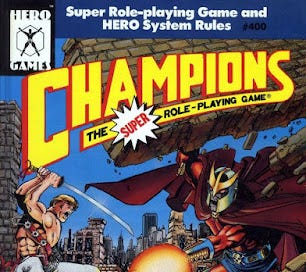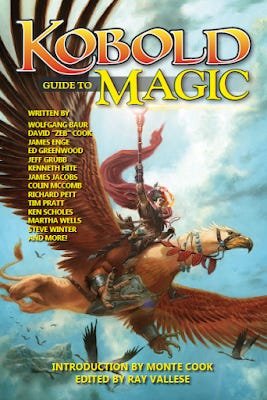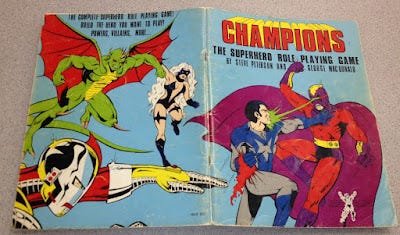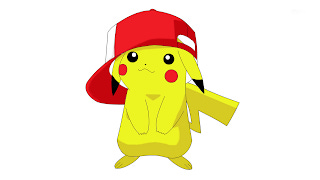Dungeons & Dilemmas: D&D Has Too Many Spells
Using a Special Effects Approach to Spell Casting in D&D Games
There are too many spells in Dungeons & Dragons rulebooks and it reduces the sense of wonder in the game. Magic systems are one of the most difficult design challenges that face prospective game designers, players, and game masters. Magic in fiction, and in our imagination, often defies quantification. In fact, one might argue that what makes magic “magical” is that it is mysterious and that by quantifying it, you diminish its impact. I am sympathetic to this view, but I actually think that having the rules present purely mechanical effects and letting players add special effects is the best way to handle this problem.
The solution that D&D often uses is what Jeff Grubb calls the "Very Large Spellbook" approach in the Kobold Guide to Magic. This works by flooding the zone with so many spells that no one really knows what every spell does and thus leaves a sense of wonder as new things are discovered. The problem with this approach is that you can end up with five different spells that turn a target's bones into liquid. This isn't bad when the mechanical effects of each spell is different, but can be a problem when many of them have pretty much the same effects with minor changes in the amount of damage done. If the spells have different mechanical effects, it allows for themed mages. If it only fiddles around the edges of damage, it isn't very interesting. Jeff Grubb's discussion of how standardizing bones into liquid spells reduced the wonder of the game, while reducing the number of times spells need to be looked up in the rules because no one knows how a specific spell works.
One solution often under utilized in D&D circles is the approach used by Champions.
Whether or not you play the game, the Champions role playing game by Hero Games is one of the best role playing games ever designed and is one that every Game Master should read for advice on how to best run a game in any system. My first experience with the game was the Revised Edition, also known as the 2nd Edition, of the game, and I spent hours upon hours making characters for the system. Okay, I spent hours and hours making my version of the X-Men for the system only to have friends who were more experienced with the system tell me how I had done everything wrong, but that's beside the point.
The thing that most struck me about Champions, and something that still amazes me, is how the game took what has come to be called an effects based approach to gaming. What is typically meant by this description is that the rules don't worry about what powers and abilities look like, rather the rules are only concerned with the in game effects of powers and abilities.
While this is a central concept to how the character creation system works in Champions, it was an idea that took a few editions to fully articulate. The first edition of the game, published in 1981, only mentions the concept in passing in the Energy Blast power and on page 29 where it describes how to model a character who can change shape using Multipower with three slots that each represent a different special effect. The second edition expands on this idea more clearly and states on page 47, "Powers in Champions have been explained thoroughly in game terms, but the special effects have been left undefined...energy may be lightning, fire, cold, sonics, radiation...The special effects of your Power can contain minor advantages and disadvantages..." By the 3rd edition of the game, the designers have moved discussion of special effects to a position at the beginning of the Powers chapter, rather than following it. On page 20 it states, "When choosing powers in Champions always start with the effect and work back to the cause." The stress here is that the mechanics are important for the adjudication of success or failure in the game, but that what something looks like in the minds of the players during the game doesn't need to be categorized in the rules.
This special effects, or effects based, approach was relatively freeform in the first three editions of Champions and is what enabled players to simulate an infinite number of effects with only limited mechanics. For this reason, I prefer to call this earlier approach to effects based design the special effects approach. This distinguishes it from the more granular effect based approach of later editions of Champions and give primacy to only quantifying what absolutely must be represented mechanically and leaving the rest to improvisation. Later editions of Champions, beginning with 4th edition which is my favorite edition, began a process of quantifying too many effects for my tastes. Given my preference for improvisation, I prefer to avoid over quantification of phenomenon. Your mileage may vary on that account, but that will have little bearing on this discussion as it continues.
So when might a special effects approach help a D&D game?
Let me look to one of my favorite online shows to explain.
An example of a situation that could have benefited from a special effects approach occurs in Episode 8 Part 1 of Saving Throw Show's series "The Lost Brigade" when Havana Mahoney attempts to have her Druid Theronna Wolfmancer cast the spell Summon Swarm upon some creatures she and her allies were combating. This event happens at around minute 41:37 in the episode (also embedded above). The Dungeon Master, Mason McDaniel, initially encourages a special effects approach when Havana asks what the spell looks like and Mason gives a few possibilities while leaving the final depiction up to her as to whether the rats she wants to summon burrow out of the earth or are vomited from her mouth. Either one of these options is narratively interesting and visually exciting. It's a good moment of game play, but this quickly gets sidetracked as the group attempts to find the spell in the rules. This leads to a few minutes of discussion which pull both the players and the audience out of the game. Eventually, it is discovered that the spell Havana wanted to cast is a Pathfinder spell. She asks if she can use it anyway, but after some discussion this is rejected and Havana sighs and casts Call Lightning. It's the first time in my life that I think I've ever seen a Druid essentially say, "yawn...I guess I'll just use the old standby Call Lightning. YAWN again. KABLAM! DRUID TAC-NUKE! Wish I could have done something interesting."
And you know what? I agree with that assessment. I really wish that Havana had been allowed to cast her 2nd level Summon Swarm spell, but how do you do that?
The first thing that you can do is to let the player use the Pathfinder spell. For a second level spell, which was the case in the episode, this wouldn't particularly damage the game as OP-finder doesn't spiral out of D&D maths until higher levels. In this case, the player would have summoned a swarm of rats that attacked the monsters as listed in the Rat Swarm entry. This isn't a bad solution, and it would have rewarded the player for an inspired narrative choice, but it isn't a special effects based approach and the search of various wiki/books delayed game play. Notice, I am not discussing that Havana's presentation of how big the swarm would be and how much damage it does wasn't accurate to the Pathfinder rules. That was merely a product of the websearch and getting her phone trapped by wiki-spam. This isn’t about “getting rules wrong” and Vana’s a great player who pushes DM creativity (she’s also a very good DM).
The second approach, the special effects approach, is to ask what special effect the player wants and what mechanics fit the expressed mechanical limits. Havana wanted to use a 2nd Level Druid spell that summoned a swarm of rats that bites foes. So the mechanical emulation is area effect damage appropriate for second level. The first spell that jumped into my head was Spike Growth.
"But," you say, "Spike Growth is a spell that transforms the ground into spiky thorn covered terrain."
Does it? Not from a special effects/effect based approach.
From this approach, the spell covers a 20 foot radius of terrain with ___________ which makes the ground difficult to walk on and which cases a creature to take 2d4 piercing damage for every 5 feet they travel. This transformation is camouflaged as to not be obvious until the victims move into it and take damage.
So here are the effects:
20 foot radius
Difficult Terrain
Moving within or into causes 2d4 piercing for every 5 ft moved.
Concealed.
Havana wanted a swarm of rats to attack the foes. This pretty much does that. All you have to do is say that Theronna Wolfmancer has summoned the rats and that the creatures will soon feel those effects. Imagine the shocked looks on the creature's faces as rats rose from the earth to devour them.
That's not all this spell could represent. It could represent an area of earth where magma has been brought close to the surface, ice spikes, the thorns in the book, a miasma in the air that chokes those who move through it. None of those effects change the mechanics of the spell, which are what define the level of the spell, but each of those feels different in play due to the role playing aspect of the game. It is key to note that the damage is piercing for creatures who have those kinds of resistances.
Personally, I like the idea of Spike Growth being a near invisible miasma of toxic spores which pierce the lungs. The again, whose to say that Call Lightning couldn't just be Lightning Rats rising up from the earth to bite opponents with their Lightning powers or even just the summoning of a Pikachu?
What are some other spells that you would/could reskin for different effects?









True, all you need is fireball.
Great write up! I am definitely going to have to grab a pdf of Champions if available.